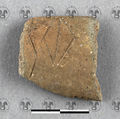Images
Ceramic fragment.
Rim sherd of a Sanzeno bowl. Fine clay, from grey to light brown in colour; very fine tempered of fine grained sand and slight argentine mica; slurry coating, smoothed and burnished; reduction firing. Due to the fragmentary state of the present rim sherd the reconstruction of the entire bowl follows the typology of the Sanzeno bowls: High and funnel-shaped neck, omphalos. The above-mentioned dimensions of the rim sherd follow the indications given in Gleirscher et al. 2002: 162.
No decorations visible. But it can be suggested that the entire bowl was decorated with either stamped decorations or stamped resp. incised striae-decorations.
Inside the rim sherd incised characters before firing.
The rim sherd was part of the findings made at the Rungger Egg. The excavations were proceeded from 1984 to 1986. The rim sherd was found in the area 53, quadrant S and this area was excavated in 1985 (cp. the map in Gleirscher et al. 2002: 18, fig. 3).
In accord with the typology the rim sherd as fragment of a Sanzeno bowl can be dated to the 3rd–2nd centuries BC.
The findspot Rungger Egg can be interpreted as site of burnt offering (cp. Gleirscher et al. 2002: 16-17). In consequence of the ritual context it can be assumed that the ceramic fragment was broken to pieces either during or after the sacrifice. Therefore almost the entire group of ceramic from the Rungger Egg is only preserved in a fragmentary state (cp. Gleirscher et al. 2002: 125-126).
The findings made at the Rungger Egg between 1984 and 1986 were published by Gleirscher, Nothdurfter and Schubert for the first time (cp. Gleirscher et al. 2002), however with particular regard to the topography as well as the history of the findspot, the excavations and the presentation of the discoveries whereas inscriptions or characters play a subordinate role.
Autopsied by the Thesaurus Inscriptionum Raeticarum in November 2014.
S.K.
S.K.
| Gleirscher et al. 2002
|
Paul Gleirscher, Hans Nothdurfter, Eckehart Schubert, Das Rungger Egg. Untersuchungen an einem eisenzeitlichen Brandopferplatz bei Seis am Schlern in Südtirol [= Römisch-Germanische Forschungen Band 61], Mainz: Philipp von Zabern 2002.
|
